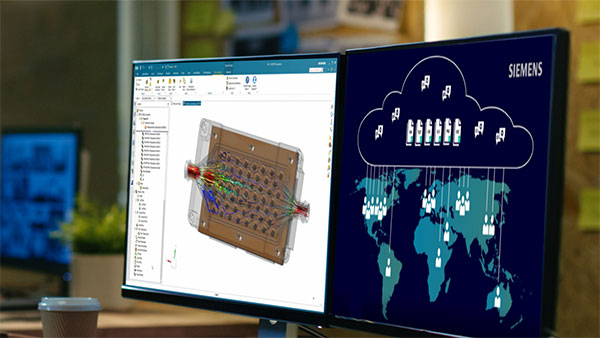Editor’s Pick: Faster CAD-Embedded CFD simulation
Siemens Simcenter FLOEFD 2205 features a new “Mesh Boolean” technology, which Siemens says can handle complex or poor-quality CAD data faster than previous methods.

Siemens Simcenter FLOEFD 2205 offers new technology for performing CFD simulation directly in a CAD environment, with an emphasis on improved geometry handling, analysis speed and engineering collaboration. Image courtesy of Siemens Digital Industries Software.
Latest News
July 6, 2022
Siemens Simcenter makes available FLOEFD 2205, an update to the company’s CAD-embedded tool for computational fluid dynamics analysis (CFD). Versions of the product are available for Siemens NX and Solid Edge, PTC Creo and Dassault Systèmes CATIA.
Leading this update is a new “Mesh Boolean” technology, which Siemens says helps handle complex or poor-quality CAD data faster than previous methods. This new technology kicks in when FLOEFD’s existing CAD Boolean approach cannot successfully finish Boolean operations. The company says this new approach is ideal for processing bad topology with such problems as missing elements and self-intersecting faces. The company claims Mesh Boolean functionality can help prepare and mesh faster without prior adjustments.
Siemens says the use of multiple chains of 1D elements in 3D CFD is improved in this version. This makes it possible to simulate pipes with a 1D solver, a faster process than using 3D equivalents, which speeds up the overall 3D CFD simulation solution. Siemens notes this new feature does not require any additional license.
FLOEFD 2205 now supports the Siemens collaboration platform Xcelerator Share. The company says this cloud-based service offers secure cloud storage with desktop application syncing, messaging, notifications and review/markup capabilities. Users can interact with engineers in other disciplines and teams in distributed locations and even collaborate with suppliers more easily.
Use of the CFD General Notation System (CGNS) is enhanced in this release. Users can now export static and transient results into other environments. Siemens says an example of the workflow would be to use CGNS export for acoustic analysis in Simcenter 3D based on a Simcenter FLOEFD field distribution.
There are new features for electronic cooling simulation. A thermal territory around a package can now be represented in Layered Mode (formerly known as Detailed). This is in addition to the existing Explicit Thermal Territory Type. Siemens says layered thermal territories provide an additional accuracy option to account for local variation of copper below a component.
There are several Smart PCB improvements. Material can be set for Via Filler and Pin Filler in Explicit and Layered modes. There is support for solder mask as solder top (SMT) and solder bottom (SMB) layers. The user can define solder mask thickness and material. For a Via group with plating, the user can now define whether the obtained via diameter is the hole diameter before plating.
The company says the memory requirement for Smart PCB structural analysis has been reduced by 2 to 30 times, depending on application. This makes thermo-mechanical analysis of complex PCBs even more feasible on desktop computers.
In multiphysics areas, structural analysis in Simcenter FLOEFD offers a new approach to allowing simulation of loosening contact. If the gap width between bodies is much less than the element size, then the contact is treated as a “Sliding” contact.
Siemens Simcenter FLOEFD 2205 is now available directly from Siemens Simcenter. More details on the product is available here.
Sources: Press materials received from the company and additional information gleaned from the company’s website.
Subscribe to our FREE magazine, FREE email newsletters or both!
Latest News
About the Author
DE’s editors contribute news and new product announcements to Digital Engineering.
Press releases may be sent to them via [email protected].






